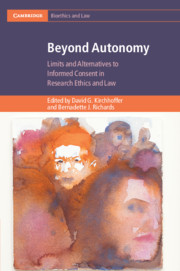Book contents
- Beyond Autonomy
- Cambridge Bioethics and Law
- Beyond Autonomy
- Copyright page
- Contents
- Tables
- Contributors
- Acknowledgements
- Introduction
- Part I Exploring Problems of Respect for Autonomy in Bioethics, Law and Society
- Part II The Search for Alternative or Complementary Concepts Surrounding Autonomy
- 5 Self-Ownership in Research Ethics
- 6 Beneficence in Research Ethics
- 7 Dignity, Being and Becoming in Research Ethics
- 8 Virtues in Research Ethics
- Part III Beyond Autonomy: Turning to the Community to Protect the Individual
- Index
- Books in the Series
6 - Beneficence in Research Ethics
from Part II - The Search for Alternative or Complementary Concepts Surrounding Autonomy
Published online by Cambridge University Press: 20 September 2019
- Beyond Autonomy
- Cambridge Bioethics and Law
- Beyond Autonomy
- Copyright page
- Contents
- Tables
- Contributors
- Acknowledgements
- Introduction
- Part I Exploring Problems of Respect for Autonomy in Bioethics, Law and Society
- Part II The Search for Alternative or Complementary Concepts Surrounding Autonomy
- 5 Self-Ownership in Research Ethics
- 6 Beneficence in Research Ethics
- 7 Dignity, Being and Becoming in Research Ethics
- 8 Virtues in Research Ethics
- Part III Beyond Autonomy: Turning to the Community to Protect the Individual
- Index
- Books in the Series
Summary
This chapter examines the explicit and implicit roles that the concept of beneficence plays in the guidelines that govern biomedical research involving humans. We suggest that the role beneficence is actually playing in the guidelines is more comprehensive than is commonly assumed. The broader conceptualisation of beneficence proposed here clarifies the relationship of beneficence to respect for autonomy. It does this by showing how respect for autonomy is at the service of beneficence rather than in tension with it.
- Type
- Chapter
- Information
- Beyond AutonomyLimits and Alternatives to Informed Consent in Research Ethics and Law, pp. 96 - 116Publisher: Cambridge University PressPrint publication year: 2019
- 1
- Cited by

